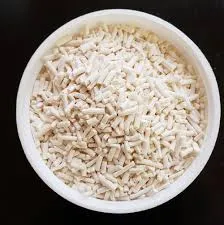
Exploring the Benefits and Uses of Maltodextrin in Food Products and Additives
Maltodextrin A Versatile Food Additive
Maltodextrin is a common food additive that has gained significant attention in the culinary and food manufacturing worlds. Known for its versatility, this carbohydrate is derived from starches—typically corn, rice, or potatoes—through a process called hydrolysis, which breaks down the starch molecules into shorter chains of glucose units. Although it might sound complex, the uses and benefits of maltodextrin in food products are quite straightforward.
What is Maltodextrin?
Maltodextrin is a white powder that is tasteless or slightly sweet in flavor. It is soluble in water, making it an efficient bulking agent and thickener within various food applications. With a glycemic index ranging from 85 to 105, maltodextrin can rapidly raise blood sugar levels, which is why it is primarily utilized in products for sports nutrition and other rapid energy sources.
Common Applications
One of the most significant applications of maltodextrin is in the production of processed foods. It can serve multiple functions 1. Thickening Agent Maltodextrin is frequently used to thicken sauces, soups, and salad dressings. 2. Bulking Agent It adds bulk to low-calorie products, helping them maintain a desirable texture without significantly increasing caloric content. 3. Preservation In dry food products, maltodextrin helps retain moisture and prolong shelf life, making it an ideal choice for instant soups, snacks, and meal replacements. 4. Sweetener Although not as sweet as sugar, maltodextrin can enhance the sweetness of products without the additional calories, which is particularly beneficial in sugar-reduced and sugar-free alternatives. 5. Carrier for Flavor and Nutrients Maltodextrin can encapsulate flavors and nutrients, thereby stabilizing them and improving their delivery in powdered supplements and beverages.
Health Considerations
maltodextrin food additive

While maltodextrin is generally recognized as safe (GRAS) by the Food and Drug Administration (FDA), there are some health considerations that consumers should be aware of. High glycemic index foods can cause rapid spikes in blood sugar, which may not be suitable for individuals with diabetes or those managing blood sugar levels. It is important for consumers to read labels carefully, especially in sports nutrition products that may contain maltodextrin in significant amounts.
Moreover, some individuals may experience gastrointestinal discomfort, such as bloating or gas, when consuming maltodextrin, especially in larger quantities. As with any food additive, moderation is key.
Maltodextrin in the Modern Diet
In the contemporary food landscape, maltodextrin is everywhere. From the snacks we crave to the sports drinks that keep us hydrated during workouts, this versatile additive plays a crucial role in the formulation of many products we consume regularly. It is especially popular in the health and wellness sector, where companies aim to create low-calorie, nutrient-dense options for health-conscious consumers.
Despite its commonality, some consumers are moving towards more natural food choices, leading to questions about the use of synthetic additives like maltodextrin. In response, some manufacturers are exploring alternatives or producing organic versions derived from non-GMO sources to cater to consumer preferences.
Conclusion
Maltodextrin is a multifaceted food additive that has found its place in a wide range of food products. Its ability to serve as a thickener, bulking agent, and preservative makes it invaluable to the food industry. However, consumers should remain mindful of its glycemic index and potential digestive issues. Whether you're a food manufacturer looking to enhance your products or a consumer navigating the food aisle, understanding maltodextrin and its role can help you make informed choices about what you eat. As the food industry continues to evolve, staying informed about additives like maltodextrin is essential for both health and nutrition.
-
Understanding Synthetic Rubber OptionsNewsApr.27,2025
-
Trichloroisocyanuric Acid: Essential for Clean and Safe WaterNewsApr.27,2025
-
Sodium Dichloroisocyanurate: Key to Safe Water TreatmentNewsApr.27,2025
-
Sodium Acid Pyrophosphate: Essential in Modern Food ProcessingNewsApr.27,2025
-
Essential Water Treatment ChemicalsNewsApr.27,2025
-
Denatured Alcohol and Its Industrial UsesNewsApr.27,2025
-
The Versatile Uses of Sodium BicarbonateNewsApr.24,2025
Hebei Tenger Chemical Technology Co., Ltd. focuses on the chemical industry and is committed to the export service of chemical raw materials.
-

view more DiethanolisopropanolamineIn the ever-growing field of chemical solutions, diethanolisopropanolamine (DEIPA) stands out as a versatile and important compound. Due to its unique chemical structure and properties, DEIPA is of interest to various industries including construction, personal care, and agriculture. -

view more TriisopropanolamineTriisopropanolamine (TIPA) alkanol amine substance, is a kind of alcohol amine compound with amino and alcohol hydroxyl, and because of its molecules contains both amino and hydroxyl. -

view more Tetramethyl Thiuram DisulfideTetramethyl thiuram disulfide, also known as TMTD, is a white to light-yellow powder with a distinct sulfur-like odor. It is soluble in organic solvents such as benzene, acetone, and ethyl acetate, making it highly versatile for use in different formulations. TMTD is known for its excellent vulcanization acceleration properties, which makes it a key ingredient in the production of rubber products. Additionally, it acts as an effective fungicide and bactericide, making it valuable in agricultural applications. Its high purity and stability ensure consistent performance, making it a preferred choice for manufacturers across various industries.











